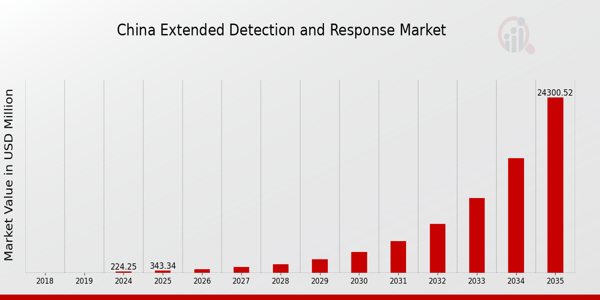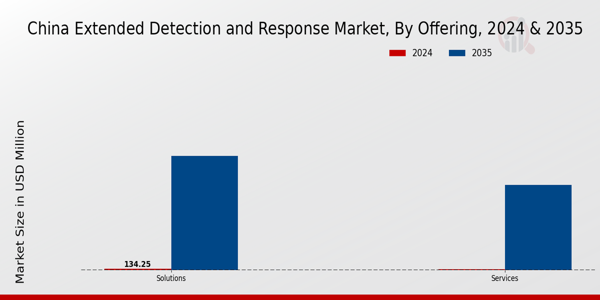China Extended Detection and Response Market Overview
As per MRFR analysis, the China Extended Detection and Response Market Size was estimated at 161.1 (USD Million) in 2023.The China Extended Detection and Response Market is expected to grow from 224.25(USD Million) in 2024 to 24,300 (USD Million) by 2035. The China Extended Detection and Response Market CAGR (growth rate) is expected to be around 53.105% during the forecast period (2025 - 2035).
Key China Extended Detection and Response Market Trends Highlighted
A number of important market factors are causing the China Extended Detection and Response (XDR) industry to grow quickly. One major factor is the rising frequency and sophistication of cyberthreats in China, where a growing number of cyberattacks target government institutions and vital infrastructure.
Stricter laws and more funding for cybersecurity technology are the results of the Chinese government's recognition of the value of strengthening cybersecurity measures. Businesses are urged by this environment to enhance their security posture by implementing cutting-edge technologies like XDR.
As Chinese enterprises move toward integrated security solutions that offer a comprehensive approach to threat detection and response, there are plenty of chances to capitalize on this expanding market. Tools that improve incident response capabilities and expedite security operations are sought after by several businesses.
The need for efficient XDR systems that can monitor and safeguard increasingly scattered networks and endpoints is growing as remote work becomes more common. Recent patterns show that Chinese businesses are becoming increasingly interested in more all-encompassing and cooperative cybersecurity solutions.
Companies are stressing the value of automated response capabilities and centralized visibility, which are now essential for effectively fending off cyberthreats. Furthermore, a major trend in cybersecurity solutions is the emergence of AI and machine learning; Chinese businesses are eager to implement these technologies to improve their XDR systems.
This emphasis on innovation supports China's overarching objective of becoming a technical leader, which will help the XDR market grow even more. With a landscape shaped by both technical advancements and regulatory challenges, the China Extended Detection and Response market is poised for substantial expansion.

Source: Primary Research, Secondary Research, Market Research Future Database and Analyst Review
China Extended Detection and Response Market Drivers
Increasing Cybersecurity Threats
The surge in cybersecurity threats in China is a significant driver for the China Extended Detection and Response Market. According to the Chinese Ministry of Public Security, there has been a report of over 140 million cyber incidents in the year 2022 alone, indicating a 30 percent increase compared to the previous year.
The increasing sophistication of cyber-attacks, especially on critical infrastructures such as finance, healthcare, and government systems, necessitates advanced detection and response solutions.
In response to these threats, major organizations like Alibaba Cloud and Tencent are investing heavily in developing robust Extended Detection and Response solutions to protect businesses across sectors. These developments are crucial to mitigate the risks associated with rising cybersecurity incidents, further propelling the market's growth in the region.
Government Initiatives and Regulation
The Chinese government's proactive stance towards enhancing cybersecurity laws and regulations is significantly driving the growth of the China Extended Detection and Response Market. The Cybersecurity Law of China, which came into effect in June 2017, emphasizes the need for enterprises to adopt comprehensive cybersecurity measures.
Furthermore, the government has launched initiatives such as the National Cybersecurity Strategy to bolster the cybersecurity framework across industries.
With the increasing regulatory requirements, organizations are actively seeking Extended Detection and Response solutions to ensure compliance and safeguard sensitive data. This regulatory environment is prompting companies like Huawei and ZTE to collaborate with local enterprises to develop tailored solutions, enhancing the market's potential in the region.
Rapid Digital Transformation
The pace of digital transformation in China is a significant factor driving the growth of the China Extended Detection and Response Market. With the increasing adoption of cloud computing, Artificial Intelligence (AI), and the Internet of Things (IoT), organizations are becoming more vulnerable to cyber threats.
According to recent statistics, over 90 percent of companies in China have accelerated their digital transformation efforts due to the COVID-19 pandemic, leading to heightened reliance on digital infrastructures.
Leading technology firms like Baidu and JD.com are expanding their digital services, thereby increasing the demand for advanced cybersecurity solutions. The need for effective Extended Detection and Response systems to secure these digital environments is vital, making this driver particularly relevant in the context of China's booming tech landscape.
China Extended Detection and Response Market Segment Insights
Extended Detection and Response Market Offering Insights
The China Extended Detection and Response Market is experiencing significant growth in its Offering segment, which encompasses a range of solutions and services designed to enhance cybersecurity measures against evolving threats.This market is characterized by the need for advanced detection and response capabilities that can address the complexities of current digital threats, especially in a rapidly digitizing economy like China.
The robust growth drivers in this segment include the increasing prevalence of cyber-attacks, rising regulatory requirements, and the growing demand for comprehensive security solutions by enterprises of all sizes.Solutions within the Offering segment play a crucial role as they provide organizations with tools for threat detection, analysis, and response orchestration, thus facilitating a proactive approach to cybersecurity.
Meanwhile, the services component is essential for implementing and managing these solutions effectively, allowing businesses to leverage expert knowledge and experience to maintain security posture in an increasingly complex cyber landscape.
The trend towards cloud-based security solutions has bolstered opportunities in this segment, given that many organizations seek flexible, scalable options that can adapt to their specific security needs. Additionally, significant investments in Research and Development by local companies in China further enhance the capability and sophistication of offerings available in the market.Amidst these trends, challenges such as skilled labor shortages and the ongoing threat of advanced persistent threats present obstacles to achieving optimal security.
Overall, the Offering segment plays a vital role in the broader scope of the China Extended Detection and Response Market, enabling firms to not only comply with regulations but also strengthen their defenses against ever-evolving threats to their operations.The market statistics highlight the importance of strategic investments in this area as businesses continue to recognize the critical need for integrated security solutions and services to navigate the complex cybersecurity landscape in China.

Source: Primary Research, Secondary Research, Market Research Future Database and Analyst Review
Extended Detection and Response Market Deployment Mode Insights
The Deployment Mode segment of the China Extended Detection and Response Market has been evolving rapidly, driven by increasing cybersecurity threats and a growing demand for efficient threat detection solutions. Organizations in China are gravitating towards On-premises and Cloud deployment models, each catering to different operational needs.The On-premises model is preferred by enterprises that prioritize data control and compliance, allowing them to manage sensitive information securely within their infrastructure. It provides advantages in customization and integration with existing systems, making it significant for sectors like finance and healthcare.
On the other hand, the Cloud deployment mode is gaining traction due to its scalability, cost-effectiveness, and flexibility, appealing to smaller businesses and organizations looking to minimize overhead costs. As the market grows, both models are expected to play crucial roles in enhancing cybersecurity strategies.Moreover, government initiatives promoting digital transformation and robust cybersecurity frameworks in China underscore the importance of both deployment methods in addressing emerging security challenges.
Extended Detection and Response Market Organization Size Insights
The Organization Size segment of the China Extended Detection and Response Market reflects the varying needs and capabilities of different size enterprises within the region. Large Enterprises typically dominate the market due to their extensive IT infrastructures and higher investment capabilities in cybersecurity solutions.
These organizations are more prone to sophisticated cyber threats, which drives their demand for advanced Extended Detection and Response systems that offer comprehensive protection. Additionally, the growing trend of digital transformation in China has resulted in an increased need for robust cybersecurity measures among larger organizations to safeguard sensitive data.On the other hand, Small and Medium-sized Enterprises (SMEs) represent a burgeoning segment, as they have been increasingly recognizing the importance of cybersecurity in maintaining operational integrity.
SMEs often face unique challenges, such as limited budgets and resources for security solutions, making them a significant focus for affordable, scalable Extended Detection and Response solutions.
The rising awareness of cyber threats among SMEs, coupled with supportive government initiatives promoting cybersecurity investment, highlights the evolving landscape of the China Extended Detection and Response Market, indicating a promising outlook for both segments as they adapt to the dynamic digital environment.Overall, the market segmentation based on Organization Size reflects not only the diverse requirements of enterprises but also underscores an opportunity for tailored cybersecurity solutions across various organizational frameworks in China.
Extended Detection and Response Market Vertical Insights
The China Extended Detection and Response Market, particularly in the Vertical segment, is experiencing notable growth, driven by the increasing prevalence of cyber threats and the vital need for advanced security solutions across various industries.The BFSI sector remains a key player, as financial institutions prioritize safeguarding sensitive data and enhancing their defenses against cyber attacks. Meanwhile, the Government sector is focusing on strengthening national security measures, thereby bolstering demand for extended detection and response capabilities.
Manufacturing, with its growing reliance on smart technologies, necessitates robust cybersecurity to protect critical infrastructure. Energy and Utilities are increasingly adopting advanced security measures to counteract threats to national resources.The Healthcare industry, amid the rise of digital health solutions, is prioritizing the protection of patient data to comply with regulations and maintain trust. Retail and eCommerce players are also embracing advanced detection and response strategies to secure transactions and customer information.
Furthermore, the IT and ITeS sector is navigating a complex threat landscape, pushing for comprehensive security frameworks to support cloud solutions. Overall, each segment showcases unique challenges and growth drivers, underscoring the significant relevance of the China Extended Detection and Response Market in addressing diverse industry-specific requirements.
China Extended Detection and Response Market Key Players and Competitive Insights
The China Extended Detection and Response (XDR) Market is characterized by a rapidly evolving landscape shaped by increasing cybersecurity threats and the growing need for advanced security solutions.As enterprises are moving towards integrated security frameworks, the demand for XDR solutions has surged due to their ability to provide enhanced visibility, rapid detection, and improved incident response across multiple environments.
Competitive insights into this market reveal a mix of local and international players vying for dominance, with companies striving to differentiate their offerings through innovative technologies, strategic partnerships, and tailored services.The dynamic nature of the Chinese market presents unique challenges, including regulatory hurdles and an intense focus on compliance, which require companies to adapt their strategies to maintain competitiveness.
Tencent has established itself as a formidable player in the China Extended Detection and Response Market, leveraging its extensive ecosystem and strong brand recognition. Through its robust cloud services and comprehensive cybersecurity offerings, Tencent is well-positioned to meet the growing demands for integrated security solutions among businesses.The company's strengths lie in its deep investment in research and development, enabling it to continuously innovate and enhance its product range. Tencent's ability to effectively combine artificial intelligence with advanced analytics not only improves threat detection but also amplifies incident response capabilities.
Its extensive user base and collaboration with various industries also bolster its presence in the market, allowing for a better understanding of customer needs and enabling tailored solutions.
Key Companies in the China Extended Detection and Response Market Include:
- Tencent
- Huawei
- Palo Alto Networks
- Fortinet
- Baidu
- Zscaler
- Check Point Software
- Microsoft
- Alibaba
China Extended Detection and Response Market Developments
Tencent Cloud XDR, a holistic security platform that seamlessly integrates threat intelligence, network traffic analysis, identity management, and endpoint detection and response (EDR), was formally introduced by Tencent in May 2025.In both cloud-native and hybrid systems, it provides automatic incident response, compliance logging, and deep forensics, allowing Chinese businesses to instantly stop malware, lateral movement, and data exfiltration.
Tencent received the "Privacy-Friendly Awards 2025" Gold Award and Best Data Breach Response Plan Award in July 2025 for its extensive security incident playbooks throughout Greater China and its strong Threat Detection and Response program.Alibaba Cloud and IBM announced a close partnership in November 2023 to include QRadar SIEM and SOAR into Alibaba Cloud's security offering. This partnership will give enterprise clients throughout Asia consolidated visibility, automated incident response, and unified real-time threat reporting.
At its Accelerate 2023 China Summit in Shanghai in November 2023, Fortinet also presented its FortiXDR roadmap and new hybrid deployment models, emphasizing improved automation, AI-driven threat detection, and deep interoperability for the Chinese industrial and financial industries.
Palo Alto Networks announced in September 2023 that its VM-Series firewalls will be supported on Tencent Cloud, allowing users to implement Cortex-backed XDR in accordance with local compliance and network-security integration.Lastly, Cisco showcased its SecureX XDR platform at Black Hat Asia 2023, which combines real-time analytics and coordinated response processes for Asia-Pacific enterprises with network, endpoint, and cloud telemetry.
China Extended Detection and Response Market Segmentation Insights
Extended Detection and Response Market Offering Outlook
Extended Detection and Response Market Deployment Mode Outlook
Extended Detection and Response Market Organization Size Outlook
Extended Detection and Response Market Vertical Outlook
-
- BFSI
- Government
- Manufacturing
- Energy and Utilities
- Healthcare
- Retail and eCommerce
- IT and ITes
- Other Verticals
| Report Attribute/Metric Source: |
Details |
| MARKET SIZE 2023 |
161.1(USD Million) |
| MARKET SIZE 2024 |
224.25(USD Million) |
| MARKET SIZE 2035 |
24300.0(USD Million) |
| COMPOUND ANNUAL GROWTH RATE (CAGR) |
53.105% (2025 - 2035) |
| REPORT COVERAGE |
Revenue Forecast, Competitive Landscape, Growth Factors, and Trends |
| BASE YEAR |
2024 |
| MARKET FORECAST PERIOD |
2025 - 2035 |
| HISTORICAL DATA |
2019 - 2024 |
| MARKET FORECAST UNITS |
USD Million |
| KEY COMPANIES PROFILED |
Tencent, Cisco, SonicWall, Huawei, Palo Alto Networks, Fortinet, CrowdStrike, Baidu, Zscaler, Check Point Software, Microsoft, McAfee, Alibaba, IBM, FireEye |
| SEGMENTS COVERED |
Offering, Deployment Mode, Organization Size, Vertical |
| KEY MARKET OPPORTUNITIES |
Growing demand for cybersecurity solutions, Increased cloud adoption in enterprises, Rising cyber threat landscape, Regulatory compliance driving investments, Integration with AI and automation technologies |
| KEY MARKET DYNAMICS |
increasing cyber threats, regulatory compliance requirements, demand for automation, growth of remote work, rising awareness and investment |
| COUNTRIES COVERED |
China |
Frequently Asked Questions (FAQ):
The China Extended Detection and Response Market is expected to be valued at 224.25 million USD in 2024.
By 2035, the market is projected to grow significantly, reaching a valuation of 24,300 million USD.
The expected CAGR for the China Extended Detection and Response Market from 2025 to 2035 is 53.105%.
Major players such as Tencent, Cisco, and Huawei are expected to hold significant market shares within the China Extended Detection and Response Market.
In 2024, the solutions segment is valued at 134.25 million USD and the services segment at 90.0 million USD.
The solutions segment is projected to be valued at 13,900 million USD by 2035.
The services segment is anticipated to grow to a value of 10,400 million USD by 2035.
Emerging trends in the market include increasing investments in cybersecurity and the integration of advanced technologies like AI and machine learning.
Challenges may include the rapid evolution of cyber threats and the need for continuous updates to security measures.
The growth in the market reflects an increasing focus on enhancing cybersecurity measures across various sectors within the region.
















